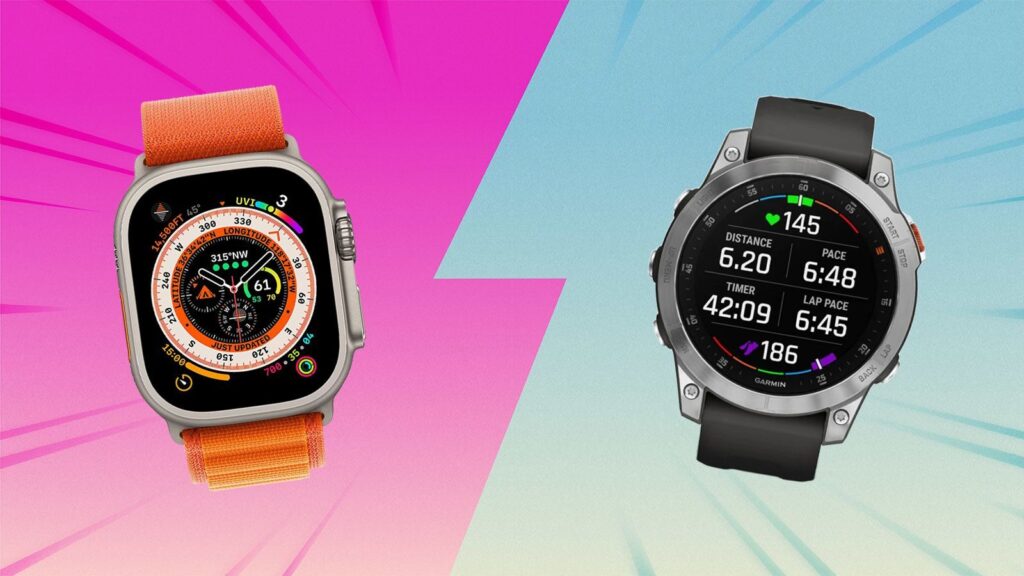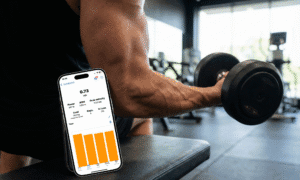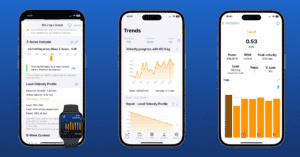When it comes to running, the debate between the Apple Watch vs Garmin has become a hot topic. Both brands offer powerful tools tailored to the needs of athletes, but the choice between the two often comes down to personal preferences and specific fitness goals. This article delves into the key differences, advantages, and unique features of each, providing a comprehensive guide for runners.
DOWNLOAD SPLEEFT APP NOW FOR PHONE, MAC AND WATCH!
Apple Watch vs Garmin for Runners
Apple Watch vs Garmin

Design and Display: Aesthetic and Functionality
Both Apple Watch and Garmin devices boast impressive designs, but they cater to different audiences. The Apple Watch is known for its sleek, modern aesthetic, making it a versatile accessory for both athletic activities and everyday wear. With its vibrant OLED display, the Apple Watch offers crystal-clear visuals, even under bright sunlight—a crucial feature for outdoor runners.
Garmin, on the other hand, prioritizes functionality with a more rugged design. Built to withstand harsh environments, Garmin watches frequently feature transflective memory-in-pixel (MIP) displays, which excel in visibility under direct sunlight. While these displays may not be as vivid as the Apple Watch’s, they are purposefully designed for endurance activities, offering extended battery life—a significant advantage for long-distance runners.
Battery Life: Endurance vs. Daily Charging
Battery life is one of the most critical factors for runners. Garmin watches are renowned for their long battery life, with some models lasting up to two weeks on a single charge. This extended battery life is a game-changer for ultra-marathoners or anyone who doesn’t want to worry about charging their device daily.
In contrast, the Apple Watch, with its high-resolution display and multitude of features, typically requires daily charging. However, the latest models, such as the Apple Watch Ultra, have improved battery performance, offering up to 36 hours of usage with standard settings. For most casual runners who charge their devices overnight, the Apple Watch’s battery life is more than sufficient.
Fitness Tracking: Comprehensive Data Collection
When it comes to fitness tracking, both Apple Watch and Garmin excel but in different ways. The Apple Watch offers a wide range of health and fitness features, including heart rate monitoring, GPS tracking, and advanced metrics like VO2 max and blood oxygen levels. The integration with the iPhone allows for seamless data synchronization, making it easy to monitor progress and analyze performance.
Garmin, however, is often favored by serious athletes and runners due to its more detailed tracking capabilities. Garmin watches offer advanced metrics such as lactate threshold, stride length, and ground contact time, which are crucial for optimizing running performance. Additionally, Garmin’s ecosystem includes tools like the Garmin Coach and advanced running dynamics, which provide personalized training plans and in-depth analysis, helping runners to fine-tune their training.
Navigation and GPS Accuracy: Precision in Every Step
For runners who venture off the beaten path, GPS accuracy and navigation tools are vital. Garmin is known for its superior GPS accuracy, particularly in challenging environments such as dense forests or urban areas with tall buildings. Garmin devices often include multi-band GNSS support, which enhances positioning accuracy by combining signals from multiple satellite systems.
The Apple Watch, while equipped with GPS, generally performs well in urban settings but may not be as reliable in more challenging terrains. However, the introduction of the Apple Watch Ultra has significantly narrowed this gap, with improved GPS capabilities that make it a strong contender even for trail runners.
App Ecosystem: Integration and Versatility
The app ecosystem is where the Apple Watch truly shines. With access to the App Store, users can download a wide range of fitness and health apps, from running-specific tools to general wellness applications. This versatility makes the Apple Watch a powerful tool not just for running but for overall health management.
Garmin’s app ecosystem, while more focused, is highly specialized. The Garmin Connect app is a robust platform for tracking and analyzing workouts, and it integrates seamlessly with other fitness platforms like Strava. For runners who prioritize detailed data analysis and specialized training tools, Garmin’s ecosystem provides everything needed to optimize performance.
Spleeft App Integration: One of the Best Apps for iWatch

One significant advantage of the Apple Watch for runners is its compatibility with the Spleeft App. Spleeft is an innovative tool that uses velocity-based training to measure barbell velocity and jump height in real-time. When installed on an Apple Watch, Spleeft offers runners detailed analytics, such as load-velocity profiles and power-load profiles, helping them to track and improve their performance in strength and conditioning workouts. What makes Spleeft one of the best Apple Watch apps for fitness.
Garmin, while offering excellent fitness tracking, does not currently support apps like Spleeft. This limitation could be a deal-breaker for runners who want to integrate their strength training data with their running performance. For those looking to combine running with strength training, the Apple Watch, paired with the Spleeft App, becomes a powerful tool, providing insights that go beyond what Garmin can offer.
Whoop Integration: Another Perspective
While the focus of this article is on the Apple Watch vs. Garmin debate, it’s worth briefly mentioning Whoop, a device that excels in recovery tracking. Whoop offers a unique perspective by focusing on recovery, sleep, and strain, making it a valuable tool for runners looking to optimize their training intensity based on recovery metrics. For a deeper comparison, you can explore more about how Apple Watch stacks up against Whoop in this comprehensive comparison: Apple Watch vs Whoop.
Which is Best for Strength and Conditioning Training for Runners?
Ultimately, the choice between Apple Watch and Garmin comes down to what you prioritize in your running routine. If you value a sleek design, integration with a wide range of apps, and the ability to track both fitness and strength training metrics, the Apple Watch, especially when paired with the Spleeft App, is an excellent choice. It offers a blend of style, functionality, and versatility that is hard to beat.
However, if you are a serious runner who prioritizes battery life, advanced running metrics, and superior GPS accuracy, Garmin is likely the better fit. Garmin’s focus on specialized tools for runners makes it the go-to choice for those who are deeply invested in their training.
For those who can’t decide, considering how each device fits into your broader fitness goals may help. If combining running with strength training is crucial, the Apple Watch’s compatibility with the best apps for iWatch, such as Spleeft, makes it a standout choice. If running performance and endurance tracking are your sole focus, Garmin’s precision and endurance make it hard to overlook.





